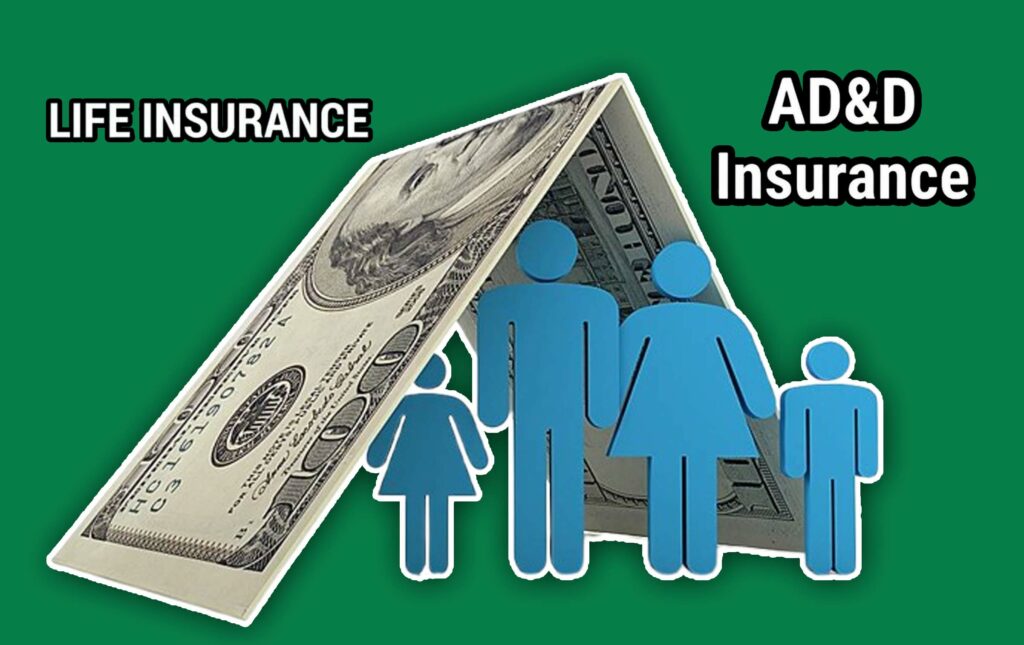Life Insurance vs. AD&D Insurance – Navigating the world of insurance can be a complex task, with a wide array of policies and terms that often sound similar but have vastly different functions. Among the most common points of confusion are life insurance and Accidental Death & Dismemberment (AD&D) insurance. While both are designed to offer financial protection, they cover very different scenarios and serve distinct purposes.

Understanding the fundamental distinction between these two policies is crucial for ensuring you and your loved ones have the right level of coverage. The wrong choice could leave your family vulnerable, while the right one could secure their financial stability for years. This article will break down Life Insurance vs. AD&D Insurance. It willdiscuss how each policy works, what they cover, who might benefit from them, and why having clarity matters.
Life Insurance: Comprehensive Financial Protection
Life insurance is often described as the cornerstone of a solid financial plan, and for good reason. It acts as a comprehensive safety net, ensuring that your loved ones are not left financially stranded if you pass away. Unlike more specialized policies, life insurance is designed to cover almost all causes of death, which makes it one of the most reliable and versatile insurance options available.
How It Works
When you purchase life insurance, you’re entering into a contract with an insurance company. In exchange for paying regular premiums, the insurer guarantees a death benefit payout to your chosen beneficiaries when you die. The size of this payout depends on the policy you select and can range from tens of thousands to several million dollars.
There are different types of life insurance policies:
- Term Life Insurance: Provides coverage for a set number of years (e.g., 10, 20, or 30). It’s generally more affordable and straightforward. If you pass away during the policy term, your beneficiaries receive the benefit. If the term expires, coverage ends unless you renew or convert it.
- Whole Life Insurance: Offers lifetime coverage and includes a cash value component that grows over time, which you can borrow against or even withdraw.
- Universal Life Insurance: A flexible type of permanent insurance that allows you to adjust your premiums and death benefits while building cash value.
This flexibility makes life insurance adaptable to different stages of life, whether you’re a young parent, a homeowner with a mortgage, or nearing retirement.
What It Covers
The coverage is very broad, which is why it’s considered indispensable. Life insurance generally pays out for:
- Illness: The most common cause of death, including cancer, heart disease, diabetes, or other chronic illnesses.
- Natural Causes: Aging-related conditions or deaths not linked to an accident.
- Accidents: From car crashes to workplace injuries, life insurance covers them all.
- Special Circumstances: Many policies cover suicide after a waiting period (commonly two years) and homicide, provided the beneficiary is not implicated.
The only major exclusions tend to be fraud, misrepresentation on the application, or extremely risky behavior not disclosed to the insurer.
Why It Matters
Life insurance isn’t just about replacing lost income; it’s about preserving stability. It can help pay off debts, cover funeral expenses, maintain your children’s education, and keep your family in their home. For many families, it’s the difference between financial hardship and ongoing security.
AD&D Insurance: A Narrow, Accident-Specific Policy
In contrast to life insurance, Accidental Death & Dismemberment (AD&D) insurance offers coverage that is far more limited. It’s designed for very specific situations and should be thought of as an add-on, not a replacement.
How It Works
AD&D coverage kicks in only if you die or suffer a qualifying injury due to an accident. It does not pay out for deaths caused by illness, old age, or other natural causes. Because of this narrower scope, AD&D policies are often easier to obtain. Many insurers don’t require medical exams or detailed health checks, which makes them accessible to people who might struggle to qualify for life insurance.
You can buy AD&D as a standalone policy, but most people purchase it as a rider attached to a life insurance policy. This way, it enhances the protection you already have by adding extra benefits for accidents. Employers sometimes also offer AD&D coverage as part of workplace benefit packages, usually at a low cost.
What It Covers
AD&D policies typically include two areas of protection:
- Accidental Death: The policy pays the benefit if your death results directly from an accident, such as a traffic collision, fire, or fall. However, accidents caused by drug use, intoxication, war, or participation in dangerous activities (like skydiving) are often excluded.
- Dismemberment: Unlike life insurance, AD&D provides partial payouts if you survive but suffer permanent injuries. For example:
- Loss of one limb may pay 50% of the benefit.
- Loss of both eyes and both hands may pay 100%.
- Loss of speech or hearing may trigger partial payouts.
The exact payout percentages vary by policy, so it’s important to read the terms carefully.
Why It Matters
AD&D insurance is most useful for people whose jobs or hobbies put them at a higher risk of accidents. While it doesn’t cover illness (the most likely cause of death), it provides financial relief in cases where sudden accidents lead to disability or death, situations that can be both financially and emotionally devastating.
Life Insurance vs. AD&D Insurance
| Feature | Life Insurance | AD&D Insurance |
| Primary Purpose | To provide a financial safety net for your family after your death, from almost any cause. | To provide a benefit for death or specific injuries caused by an accident. |
| Causes of Death Covered | All causes, including illness, natural causes, and accidents. | Only accidental death. |
| Injury Coverage | Does not cover non-fatal injuries. | Provides benefits for specific severe, non-fatal injuries (dismemberment). |
| Cost | Generally more expensive due to broader coverage. | Much more affordable due to its narrow, limited coverage. |
| Underwriting | Requires a more thorough underwriting process, often including a medical exam. | Simplified underwriting; often does not require a medical exam. |
Who Should Consider Each Policy?
- Life Insurance is for everyone who has dependents. If your family relies on your income to pay for a mortgage, education, daily living expenses, or other debts, life insurance is a non-negotiable part of your financial plan. It protects against the most likely cause of death—illness—which AD&D does not.
- AD&D Insurance is a valuable supplement, not a replacement. It can be particularly useful for individuals in high-risk professions (e.g., construction workers, pilots) or those with dangerous hobbies who want extra protection against a specific type of risk. It can also be a simple and affordable way to get some form of coverage if you are not eligible for traditional life insurance due to pre-existing health conditions.
Conclusion
While life insurance and AD&D insurance both offer financial protection, they are not interchangeable. Life insurance provides a broad, comprehensive safety net for almost any eventuality, while AD&D insurance is a highly specific policy designed to cover only the consequences of an accident.
For most people, a robust life insurance policy is the cornerstone of their financial protection. AD&D should be viewed as a supplemental tool to enhance that protection, offering an added layer of security for the specific and rare event of an accidental death or dismemberment.



